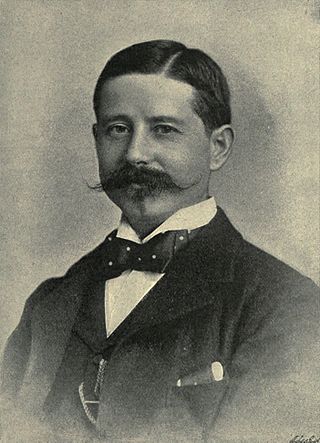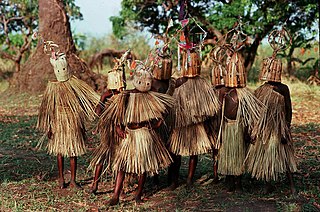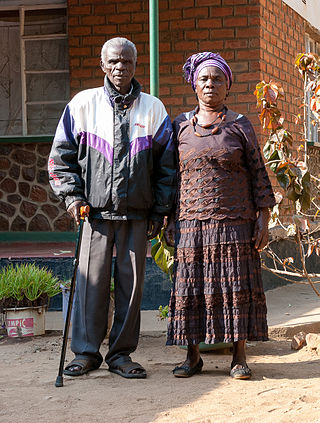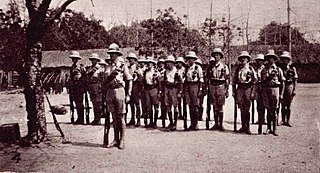Related Research Articles
The History of Malawi covers the area of present-day Malawi. The region was once part of the Maravi Empire. In colonial times, the territory was ruled by the British, under whose control it was known first as British Central Africa and later Nyasaland. It becomes part of the Federation of Rhodesia and Nyasaland. The country achieved full independence, as Malawi, in 1964. After independence, Malawi was ruled as a one-party state under Hastings Banda until 1994.

The British Central Africa Protectorate (BCA) was a British protectorate proclaimed in 1889 and ratified in 1891 that occupied the same area as present-day Malawi: it was renamed Nyasaland in 1907. British interest in the area arose from visits made by David Livingstone from 1858 onward during his exploration of the Zambezi area. This encouraged missionary activity that started in the 1860s, undertaken by the Universities' Mission to Central Africa, the Church of Scotland and the Free Church of Scotland, and which was followed by a small number of settlers. The Portuguese government attempted to claim much of the area in which the missionaries and settlers operated, but this was disputed by the British government. To forestall a Portuguese expedition claiming effective occupation, a protectorate was proclaimed, first over the south of this area, then over the whole of it in 1889. After negotiations with the Portuguese and German governments on its boundaries, the protectorate was formally ratified by the British government in May 1891.

Sir Henry Hamilton Johnston was a British explorer, botanist, artist, colonial administrator, and linguist who travelled widely across Africa to speak some of the languages spoken by people on that continent. He published 40 books on subjects related to the continent of Africa and was one of the key players in the Scramble for Africa that occurred at the end of the 19th century.

Frederick John Dealtry Lugard, 1st Baron Lugard, known as Sir Frederick Lugard between 1901 and 1928, was a British soldier, mercenary, explorer of Africa and a colonial administrator. He was Governor of Hong Kong (1907–1912), the last Governor of Southern Nigeria Protectorate (1912–1914), the first High Commissioner (1900–1906) and last Governor (1912–1914) of Northern Nigeria Protectorate and the first Governor-General of Nigeria (1914–1919).

The Tumbuka is a Bantu ethnic group found in Malawi, Zambia and Tanzania. Tumbuka is classified as a part of the Bantu language family, and with origins in a geographic region between the Dwangwa River to the south, the North Rukuru River to the north, Lake Malawi to the east, and the Luangwa River. They are found in the valleys near the rivers, lake as well as the highlands of Nyika Plateau, where they are frequently referred to as Henga although this is strictly speaking the name of a subdivision.

Karonga is a township in the Karonga District in Northern Region of Malawi. Located on the western shore of Lake Nyasa, it was established as a slaving centre sometime before 1877. As of 2018 estimates, Karonga has a population of 61,609. The common and major language spoken in this district is the Tumbuka language, which is also a regional language of Northern Malawi.
The African Lakes Corporation plc was a British company originally set-up in 1877 by Scottish businessmen to co-operate with Presbyterian missions in what is now Malawi. Despite its original connections with the Free Church of Scotland, it operated its businesses in Africa on a commercial rather than a philanthropic basis. It had political ambitions in the 1880s to control part of Central Africa and engaged in armed conflict with Swahili traders. Its businesses in the colonial era included water transport on the lakes and rivers of Central Africa, wholesale and retail trading including the operation of general stores, labour recruitment, landowning and later an automotive business. The company later diversified, but suffered an economic decline in the 1990s and was liquidated in 2007. One of the last directors of the company kindly bought the records of the company and donated them to Glasgow University Archive Services, where they are still available for research.
The Nyakyusa are a Bantu ethnolinguistic group who live in the fertile mountains of southern Mbeya Region of Tanzania and the Northern Region of Malawi. They speak the Nyakyusa language, a member of the Bantu language family. In 1993 the Nyakyusa population was estimated to number 1,050,000, with 750,000 living in Tanzania. Nyakyusa are marked as highly educated and eager agriculturists. The Nyakyusa are colonising people where success and survival depended on individual effort. Nyakyusa have managed to collect vast wealth from trade and agriculture than any tribe in Tanzania..
Karonga is a district in the Northern Region of Malawi. The district covers an area of 3,355 km.² and has a population of 365,028. It is a border district between Malawi and Tanzania's Mbeya Region's Kyela District and is mainly occupied by the Tumbuka and Nkhonde tribes. Other tribes include Henga tribe.

The Yao people are a major Bantu ethnic and linguistic group living at the southern end of Lake Malawi. They played an important role in the history of Southeast Africa, notably in the 19th century. The Yao are a predominantly Muslim-faith group of about two million, whose homelands encompass the countries of Malawi, the north of Mozambique, and the Ruvuma and Mtwara Regions of Tanzania. The Yao have a strong cultural identity, transcending national borders.

The Kinga are an ethnic and linguistic group native to Mbeya Region and Makete District of Njombe Region, Tanzania, in the great Kipengere Range northeast of Lake Malawi. In 2003 the Kinga population was estimated to number 140,000.

Islam is the second largest religion in Malawi behind Christianity. Nearly all of Malawi's Muslims adhere to Sunni Islam. Though difficult to assess, according to the CIA Factbook, in 2018 about 13.8% of the country's population was Muslim. Muslim organisations in the country claim a figure of 15-20%. According to the latest census (2018), Muslims make up 13.8% (2,426,754) of the country's population. According to the Malawi Religion Project run by the University of Pennsylvania, in 2010 approximately 19.6% of the population was Muslim, concentrated mostly in the Southern Region.

Sir Alfred Sharpe was Commissioner and Consul-General for the British Central Africa Protectorate and first Governor of Nyasaland.

Robert Laws FRGS FRSGS (1851–1934) was a Scottish missionary who headed the Livingstonia mission in the Nyasaland Protectorate for more than 50 years. The mission played a crucial role in educating Africans during the colonial era. It emphasized skills with which the pupils could become self-sufficient in trade, agriculture or industry as opposed to working as subordinates to European settlers. Laws supported the aspirations of political leaders such as Simon Muhango and Levi Zililo Mumba, both educated at Livingstonia schools.

The Chikulamayembe are a dynasty of kings established among the Tumbuka people in the Nkhamanga-Henga area of Northern Malawi. The Chikulamayembe originally ruled from around 1805, becoming weaker from the 1830s and losing power by the 1870s and their dynasty was re-established in 1907.
John Buchanan (1855–1896), was a Scottish horticulturist who went to Central Africa, now Malawi, in 1876 as a lay member of the missionary party that established Blantyre Mission. Buchanan came to Central Africa as an ambitious artisan: his character was described as dour and devout but also as restlessly ambitious, and he saw in Central Africa a gateway to personal achievement. He started a mission farm on the site of Zomba, Malawi but was dismissed from the mission in 1881 for brutality. From being a disgraced missionary, Buchanan first became a very influential planter owning, with his brothers, extensive estates in Zomba District. He then achieved the highest position he could in the British administration as Acting British Consul to Central Africa from 1887 to 1891. In that capacity declared a protectorate over the Shire Highlands in 1889 to pre-empt a Portuguese expedition that intended to claim sovereignty over that region. In 1891, the Shire Highlands became part of the British Central Africa Protectorate. John Buchanan died at Chinde in Mozambique in March 1896 on his way to visit Scotland, and his estates were later acquired by the Blantyre and East Africa Ltd.
The Diocese of Karonga is a see of the Roman Catholic Church suffragan of the Roman Catholic Archdiocese of Lilongwe. In 2010, it counted 61,000 baptized people among a population of 400,000 inhabitants. Its current bishop is Martin Anwel Mtumbuka.
The Makololo chiefs recognised by the governments of colonial Nyasaland and independent Malawi have their origin in a group of porters that David Livingstone brought from Barotseland in the 1850s to support his first Zambezi expedition that did not return to Barotseland but assisted Livingstone and British missionaries in the area of southern Malawi between 1859 and 1864. After the withdrawal of the Universities' Mission to Central Africa those Makololo remaining in the Shire valley used firearms provided by the Europeans to attract dependants seeking protection, to seize land and to establish a number of chieftainships. At the time that a British protectorate was established in 1891, there were seven Makololo chiefs of which six were recognised by the government. Five survived to be given local governmental powers in 1933, and these powers continued after Malawi became independent. Although called Makololo or Kololo, after the ruling group in Barotseland in the 1850s, the majority came from peoples subject to the Makololo who adopted the more prestigious name. As, regardless of their origin, they took wives from among the inhabitants of the Shire Valley, their modern descendants have little connection with the Kololo people apart from their name.
The Jumbes of Nkhotakota were a dynasty of Swahili Arab traders based in Nkhotakota, on the western shore of Lake Malawi. They were running an East-West caravan trade, exchanging cloths from the Swahili coast for ivory and slaves. They introduced the Muslim faith and culture in the Nkhotakota area and were the first to grow rice and coconuts in the region.

The Nyasaland Volunteer Reserve (NVR) was a British Colonial Auxiliary Forces unit raised in the British protectorate of Nyasaland. The British Central Africa Volunteer Reserve was formally established by the colonial government in 1901 and was renamed when the protectorate became Nyasaland in 1907. In the initial years the unit was little more than a rifle shooting club with no uniform and no military training. The NVR was placed on a more formal standing in 1908 under the Volunteer Ordinance. This implemented residency and racial requirements for membership and made provision for the unit to be mobilised by the governor. The unit was initially formed of four sections but grew to seven sections by 1914 and by 1930 the unit had ten.
References
- ↑ Kalinga (1980), p. 209
- ↑ Rotberg, p.15
- 1 2 Kalinga (1980), p. 218
- ↑ Douglas, pp. 52-3
- ↑ McCracken (2012), pp. 22, 26
- ↑ Douglas, pp. 72-4
- ↑ McCracken (2012), p. 22
- ↑ Thompson, pp. 6-7, 12-13, 16
- ↑ Thompson, pp. 19-22
- ↑ Thompson, pp. 26-7
- 1 2 3 Lamba, pp. 20-1
- ↑ Kalinga (1980), p. 211
- ↑ Kalinga (1980), pp. 209
- ↑ McCracken (2012), pp. 27, 51
- ↑ Fotheringham, pp. 12-13, 39
- ↑ Pachai (1967), p. 57
- ↑ McCraken (2012), p. 49
- ↑ Lamba, pp. 15-16
- ↑ McCracken (2012), pp. 51-2
- ↑ Lamba, pp. 17-18
- ↑ Pachai (1978), pp. 36, 151-7, 171
- 1 2 Kalinga (1980), pp. 216-7
- ↑ McCracken (1977), pp. 199-200
- ↑ Kalinga (1980), pp. 211-13
- ↑ Kalinga (1980), p. 217
- ↑ Kalinga (2012), pp. 7–8, 33
- ↑ Terry (Part II), pp. 39–41
- ↑ Kalinga (1980), pp. 215-6, 218
- ↑ Fotheringham, pp. 34–7
- ↑ Fotheringham, pp. 36-7, 45
- ↑ Terry (Part I), p. 57
- ↑ Fotheringham, pp. 51, 61-3
- 1 2 3 McCracken (2012), p. 52
- ↑ McCraken (1977), pp. 139
- ↑ Lugard, p. 55
- ↑ Terry (Part I), pp. 58-60
- ↑ Terry (Part I), pp. 61-3
- ↑ Terry (Part I), pp. 63-5
- ↑ Lugard, pp. 48-9
- ↑ Terry (Part I), pp. 68-71
- ↑ Lugard, pp. 66-7
- ↑ Lugard, p. 66–67
- ↑ Terry (Part I), pp. 74–75
- ↑ Lugard, p. 111–17
- ↑ Terry (Part II), pp. 20-3, 28
- ↑ Terry (Part II), p. 30
- ↑ Terry (Part II), pp. 31-3
- ↑ Lugard, p. 135–36
- ↑ Terry (Part II), pp. 31–33
- ↑ Terry (Part II), p. 39
- ↑ McCracken (2012), pp. 57-8
- ↑ Terry (Part II), pp. 41-3
- ↑ Terry (Part II), pp. 43-4
- ↑ J McCracken (2012), pp. 61-3
- ↑ Kalinga (2012), p. 33
- ↑ Pouwels, pp. 130-2